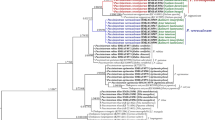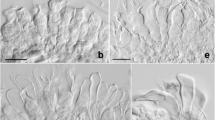Abstract
Ornamental roses worldwide harbor 10Phragmidium species. Among theseP. americanum, P. fusiforme, P. montivagum, P. mucronatum, P. rosae-pimpinellifoliae, P. rosae-rugosae andP. tuberculatum are frequently reported; however, these species are morphologically similar and difficult to distinguish. For better circumscription and correct identification of the species, this study examined morphological features in urediniospores and teliospores of the sevenPhragmidium species collected on ornamental rose cultivars and wild species. The results indicated that some host-specific groups could be well circumscribed by the morphological properties of urediniospores and teliospores. However, without the precise identification of hosts, these morphological properties were not effective key characters for the identification of the species.
Similar content being viewed by others
Literature cited
Arthur, J. C. 1909. North America rose rusts. Torreya9: 21–28.
Arthur, J. C. 1934. Manual of the rust in United States and Canada, Hafner Publ. Co., New York.
Azbukina, Z. M. 1984. Key to the rust fungi of the Soviet Far East. Nauka, Moscow. (In Russian.)
Beales, P., Cairns, T., Duncan, W., Fagan, G., Grant, W., Grapes, K., Harkness, P., Hughes, K., Mattock, J. and Ruston, D. 1998. Botanica's roses. Randomhouse Australia Pty. Ltd., Sydney.
Cummins, G. B. 1931.Phragmidium species of North America: Differential teliospore and aecial characters. Mycologia23: 433–445.
Cummins, G. B. and Hiratsuka, Y. 1983. Illustrated genera of rust fungi. Revised edn. Amer. Phytopathol. Soc., St. Paul, Minnesota.
Dietel, P. 1905. Uber die arten der GattungPhragmidium. Hedwigia44: 112–132.
Dietel, P. 1906. Uber die arten der GattungPhragmidium II. Hedwigia44: 330–346.
Gäumann, E. 1959. Die Rostpilze Metteleuropas. Beiträge zur Kryptogamenflora der Schweiz12: 1–1407.
Hiratsuka, N. 1935.Phragmidium of Japan. Jpn. J. Bot.7: 227–299.
Hiratsuka, N., Sato, S., Katsuya, K., Kakishima, M., Hiratsuka, Y., Kaneko, S., Ono, Y., Sato, T., Harada, Y., Hiratsuka, T. and Nakayama, K. 1992. The rust flora of Japan. Tsukuba Shuppankai, Tsukuba.
Hiratsuka, Y. 1973. The nuclear cycle and terminology of spore state in Uredinales. Mycologia65: 432–443.
Horst, R. K. 1983. Compendium of rose disease. Amer. Phytopathol. Soc., St. Paul, Minnesota.
Howden, J. C. W. and Jacobs, L. 1973. Report on the rust work at Bath. Ann. Natl. Rose Soc. England1973: 113–119.
Jennings, D. M., Ford-Ilyoid, B. V. and Butler, G. M. 1989. An aniline blue squash technique for observation of urediniospore germ pores. Mycol. Res.92: 230–251.
Kasai, M. 1910. On the Japanese species ofPhragmidium. Trans. Sapporo Nat. Hist. Soc.3: 25–51.
Laundon, G. F. 1970. Additions to the rust fungi of New Zealand-5. New Zealand J. Bot.8: 310–319.
Müller, J. 1886. Die Rostpilze derRosa- undRubus- Arten und die auf ihnen vorkomenden parasiten. Ber. Deutsch. Bot. Ges.3: 391–395.
Ono, Y. 2000. Taxonomy of thePhakopsora ampelopsidis species complex on vitaceous hosts in Asia including a new species,P. euvitis. Mycologia92: 154–173.
Phillips, R. and M. Rix. 1994. Roses. Pan Books Ltd., London.
Peck, C. H. 1876. Report of the botanist. Ann. Rep. New York State Mus.28: 31–88.
Pirone, P. P., Dodge, B. O. and Ricket, H. W. 1960. Disease and pests of ornamental plants. 3rd edn. Ronald Press Co., New York.
Pfunder, M., Schürch, S. and Roy, B. A. 2001. Sequence variation and geographic distribution of pseudoflower-forming rust fungi (Uromyces pisi s. lat.) onEuphorbia cyparissias. Mycol. Res.105: 57–66.
Rayner, R. W. 1970. A mycological colour chart. Commonwealth Mycological Institute, Kew.
Roy, B. A., Vogler, D. R., Bruns, T. D. and Szaro, T. M. 1998. Cryptic species in thePuccinia monoica complex. Mycologia90: 846–853.
Schröter, J. 1872. Die Brand- und Rostpilze Schlesiens. Abh. Schles. Ges. Nat. Med.1869–72: 1–31.
Stuessy, T. F. 1990. Plant taxonomy. The systematic evaluation of comparative data. Columbia Univ. Press, New York.
Wei, S. 1988. A taxonomic study of the genusPhragmidium of China. Mycosystema1: 179–210.
Wilkinson, L. 1989. SYSTAT: the system for statistics. Version 5.2 edition. Systat, Inc., Evanston, Illinois.
Wilson, M. and Henderson, D. M. 1966. British rust fungi. Cambridge Univ. Press, London.
Author information
Authors and Affiliations
Corresponding author
About this article
Cite this article
Wahyuno, D., Kakishima, M. & Ono, Y. Morphological analyses of urediniospores and teliospores in sevenPhragmidium species parasitic on ornamental roses. Mycoscience 42, 519–533 (2001). https://doi.org/10.1007/BF02460950
Received:
Accepted:
Issue Date:
DOI: https://doi.org/10.1007/BF02460950




